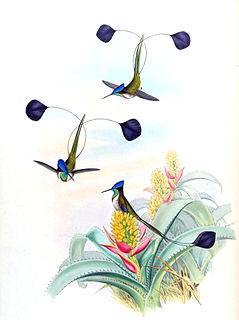
Mirabilis jalapa, the marvel of Peru or four o'clock flower, is the most commonly grown ornamental species of Mirabilis plant, and is available in a range of colors. Mirabilis in Latin means wonderful and Jalapa is the state capital of Veracruz in México. Mirabilis jalapa was cultivated by the Aztecs for medicinal and ornamental purposes.

Manduca quinquemaculata, the five-spotted hawkmoth, is a brown and gray hawk moth of the family Sphingidae. The caterpillar, often referred to as the tomato hornworm, can be a major pest in gardens; they get their name from a dark projection on their posterior end and their use of tomatoes as host plants. Tomato hornworms are closely related to the tobacco hornworm Manduca sexta. This confusion arises because caterpillars of both species have similar morphologies and feed on the foliage of various plants from the family Solanaceae, so either species can be found on tobacco or tomato leaves. Because of this, the plant on which the caterpillar is found does not indicate its species.

The marvelous spatuletail is an Endangered species of hummingbird in the "brilliants", tribe Heliantheini in subfamily Lesbiinae. It is endemic to northern Peru.

Hyles lineata, also known as the white-lined sphinx, is a moth of the family Sphingidae. They are sometimes known as the hummingbird moth because of their bird-like size and flight patterns.

Hecatera is a moth genus in the family Noctuidae erected by Achille Guenée in 1852.

Giganteopalpus is a monotypic moth genus in the family Sphingidae first described by Adolph Huwe in 1895. Its only species, Giganteopalpus mirabilis, described by Walter Rothschild in 1895, is known from Sundaland.

Temnora mirabilis is a moth of the family Sphingidae. It is known from Kenya and Rwanda.
Hysterocladia is a genus of moths in the family Megalopygidae.

Camptoloma mirabilis is a moth of the subfamily Arctiinae first described by Roepke in 1943. It is found on Java, Peninsular Malaysia and Borneo. The species is found in montane habitats.
Kurama mirabilis is a moth in the family Drepanidae. It was described by Arthur Gardiner Butler in 1879. It is found in Japan.
Hysterocladia tolimensis is a moth of the family Megalopygidae. It was described by Walter Hopp in 1927. It is found in Colombia.
Hysterocladia conjuncta is a moth of the family Megalopygidae. It was described by Walter Hopp in 1927. It is found in Ecuador.
Hysterocladia elongata is a moth of the family Megalopygidae. It was described by Walter Hopp in 1927. It is found in Peru.
Hysterocladia latiunca is a moth of the family Megalopygidae. It was described by Walter Hopp in 1927. It is found in Brazil.
Hysterocladia primigenia is a moth of the family Megalopygidae. It was described by Walter Hopp in 1927. It is found in Peru.
Hysterocladia corallocera is a moth of the Megalopygidae family. It was described by Felder in 1874. It is found in Venezuela and French Guiana.
Hysterocladia eriphua is a moth of the Megalopygidae family. It was described by Paul Dognin in 1914. It is found in Panama.
Hysterocladia lena is a moth of the Megalopygidae family. It was described by Schaus in 1912. It is found in Costa Rica.
Hysterocladia roseicollis is a moth of the Megalopygidae family. It was described by Paul Dognin in 1914. It is found in Peru and French Guiana.
Hysterocladia unimana is a moth of the family Megalopygidae. It was described by Walter Hopp in 1943. It is found in Brazil.







